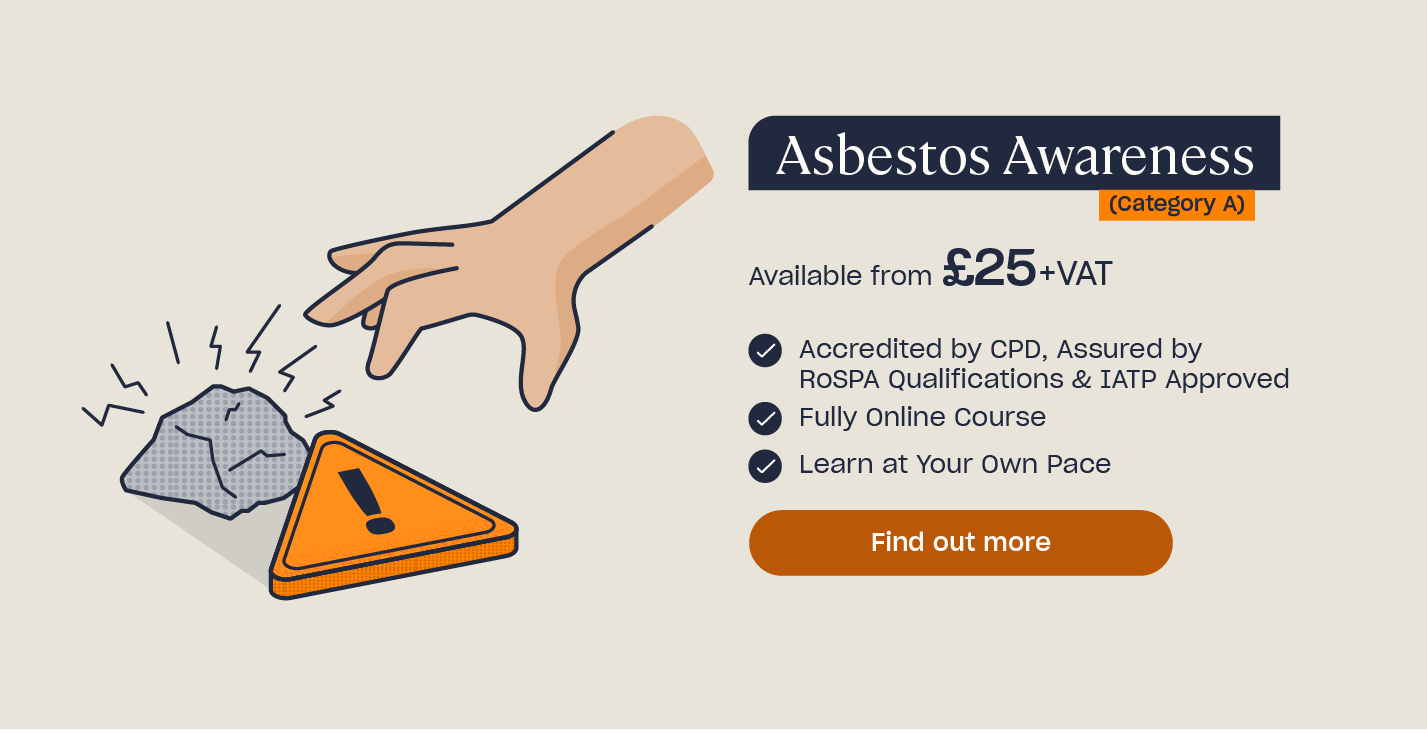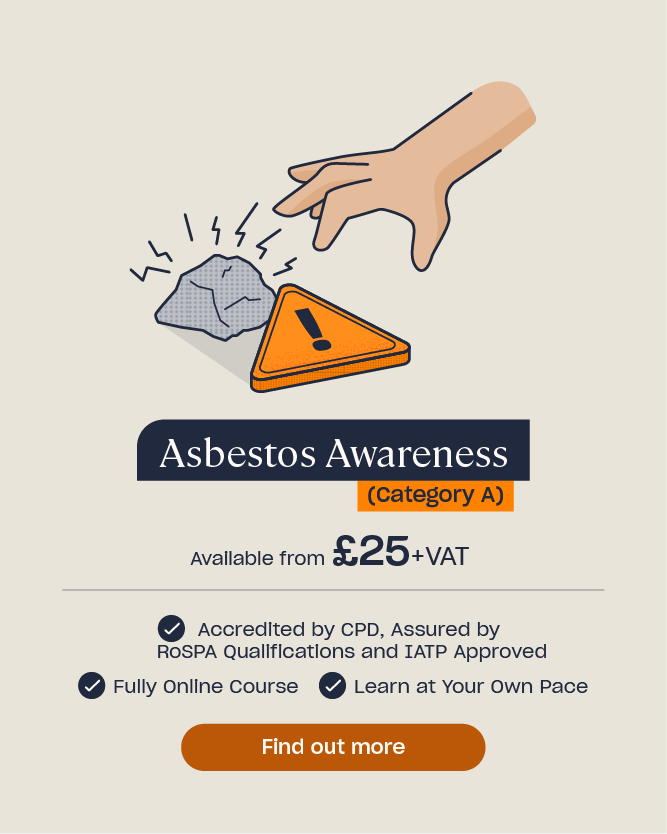What to Do if Exposed to Asbestos
Asbestos is a naturally occurring substance that is extremely harmful to health, causing over 5000 deaths in the UK each year. Breathing in asbestos fibres poses a severe risk to health by causing cancers and other diseases. It is the single largest cause of death to workers in the UK.
In this article, we will outline the impact of asbestos exposure and how you might spot the symptoms. We will also provide you with guidance on what to do if you believe that you have been exposed to asbestos and how the risks of exposure can be managed.
What is Asbestos Exposure?
If asbestos or asbestos-containing materials (ACMs) are disturbed, the tiny asbestos fibres can be released into the air. These can then be breathed in, getting trapped in the lungs and potentially causing scarring and inflammation. This affects breathing and leads to serious health problems.

Effects of Asbestos Exposure
Some asbestos-related diseases include:
Asbestos-related lung cancer. This malignant tumour of the lungs’ air passages can cause an obstruction that looks similar to lung cancer caused by smoking.
Asbestosis and fibrosis. Scarring of the lung tissue leads to breathing difficulties and can cause further complications, including heart failure.
Mesothelioma. A cancer of the cells that make up the lining around the outside of the lungs and inside the ribs (the pleura), or of the abdominal wall.
Pleural plaques. These affect the pleura adjacent to the ribs, with around 20% to 60% of people exposed to asbestos developing pleural plaques.
Asbestos warts and corns. These can form both on the skin and around major organs.
Symptoms of Asbestos Exposure
Not all asbestos-related diseases or conditions cause symptoms. A lack of symptoms is not an indication of good health. If you believe you could have been exposed to asbestos, either recently or in the past, you must speak with your GP.
However, as the lungs are the most likely organ to be affected by the inhalation of asbestos fibres, and this presents a risk of developing cancer, you should always seek medical advice if you experience any of the following:
- Chest pain.
- Breathlessness.
- Weakness.
- Weight loss.
- Fever.
- Fatigue.
- Abdominal pain.
- Malaise.
This is not an exhaustive list but these symptoms are commonly associated with an underlying health issue and should, therefore, always be addressed.
How Long After Asbestos Exposure Before Symptoms Occur?
There is no safe level of exposure when it comes to asbestos, but there are certain factors that can increase the risk of developing an asbestos-related disease, such as:
- The friability (how easily the materials crumble) of the ACMs.
- The amount of fibres released into the air.
- The duration of exposure.
- The degree of exposure.
There is no hard and fast rule on how long after exposure you are likely to develop symptoms, either. As we have mentioned, not all asbestos-related conditions present with symptoms and each health concern can have a variable latency period. For example, it can be anywhere between 15 to 60 years from initial exposure before mesothelioma becomes apparent, at which stage it is a fatal diagnosis. Whereas, asbestos-related lung cancer or fibrosis are often detected within 20 to 30 years of exposure.
The ill health effects of exposure to asbestos fibres can also be worsened by smoking, with a 2013 study showing that non-smokers who are exposed to asbestos over an extended period are five times more likely to die from lung cancer than the general population.
Looking for a Course?
Our Asbestos Awareness Training provides you with the knowledge you need to help keep yourself and others safe from the risks of asbestos exposure. This is essential for anyone who could potentially be exposed to asbestos during their work.
What Should You Do After Recent Exposure to Asbestos?
As part of any health and safety management processes, there should be emergency procedures in place to deal with the discovery or accidental disturbance of asbestos. Everyone who is at risk of potential exposure should understand the specific, immediate actions that need to be taken should this event occur.
Initial key steps to take are:
- Stop work immediately and put up warning signs.
- Keep everyone out of the area.
- Report the problem to the person in charge.
- Follow the left-hand column of the EM1 flowchart if the material does contain asbestos and follow all stated actions.
The HSE EM1 flowchart is a key guidance document provided by the HSE. You can access this here.

How to Prevent Asbestos Exposure
The primary way to ensure the risks of asbestos exposure are managed effectively, is to ensure that The Control of Asbestos Regulations 2012 (CAR 2012) are adhered to at all times. The regulations cover the key duties of those in control of places where asbestos may be present, including identifying and managing it and ensuring that others are aware of its presence.
Your personal responsibility to manage the risks will depend on your position. For example, under the regulations, employers and premises owners have additional responsibilities to employees. Employers are responsible for ensuring a risk assessment that addresses the controls for asbestos is undertaken, drawing up a written plan of work for any work which may disturb asbestos and an emergency plan outlining the correct actions to take in the event of discovery or accidental disturbance of asbestos.
Regardless of your role, it is vital that you comply with the regulations, follow any risk assessments, plans and protocols in place, and work in line with any safety measures required, such as avoiding certain areas and using certain personal protective equipment (PPE) or respiratory protective equipment (RPE) when advised.
You must also complete the appropriate training for your role and responsibilities. The different types of training includes:
- Asbestos Awareness Training (Category A).
- Non-Licensed Asbestos Training (Category B).
- Licensed Asbestos Work (Category C).
To find out more on the most appropriate category of training for you, take a look at our article on the Three Types of Asbestos Training.
It is essential that everyone, particularly those most likely to work with or around asbestos, are aware of the dangers it can pose to health. By understanding how to manage the risk of exposure and how to act in the event of discovery or accidental disturbance of this dangerous material, you will be better able to protect yourself and those around you from harm.
Further Resources:
- Asbestos Awareness Course
- What is Asbestos Awareness Training & Who Needs it?
- What is an Asbestos Management Plan?
- Can You Remove Asbestos Yourself?











